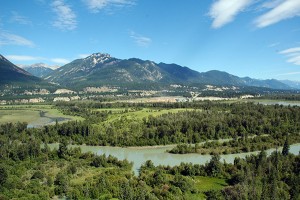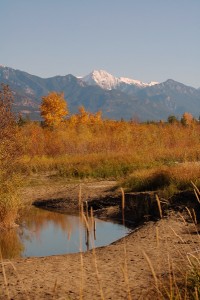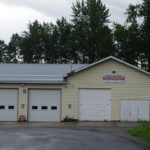Home »

Wonderstruck by the Columbia Wetlands
By Nicole Trigg

Dr. Suzanne Bayley thinks it must have been 50 years ago – and decades before she even moved to Canada – when she drove through Sinclair Canyon at the west gate of Kootenay National Park and saw the Columbia River Wetlands for the first time.
“I saw those wetlands, and the mountains shining behind them, and I said to myself: ‘I want to live here’.”
She was a young woman in her 20s with a far-reaching career in wetlands ecology still ahead of her. One that began in the 1970s with a PhD from John Hopkins University, followed by Post Doctoral Fellowship and Assistant Professor positions with the University of Florida, before she stepped into the consecutive roles of Director of Coastal Zone Management for the State of Maryland and Director of Coastal Ecology Laboratory (and Associate Professor) for Louisiana State University.
When she moved to Canada and married Dr. David Schindler, her work north of the 49th parallel began. Suzanne first worked at the Experimental Lakes Area in northwest Ontario, then moved west to become an Associate Professor and Professor of Ecology at the University of Alberta from 1989 to 2010. She’s now an Emeritus Professor of Ecology and most recently, in 2016, became the President of the Columbia Wetlands Stewardship Partners.
“I’m here (in the Columbia Valley) because of the wetlands,” Suzanne said.

While her research has focused on the ecology and management of wetlands and shallow lakes, Suzanne’s primary focus has been in applied ecology and enhancing the understanding of the value, health and ecological processes of wetlands. She has worked extensively to determine techniques to assess the health of wetlands and shallow lakes throughout the southeastern States, NW Ontario, Manitoba and Alberta, and she has also worked with Parks Canada on the Banff Bow Valley Study to determine the appropriate levels of human development in Banff National Park.
As president of the Columbia Wetlands Stewardship Partners (CWSP), Suzanne’s primary interest now is to work with local residents to ensure that the Columbia Wetlands and Columbia Valley maintain a healthy natural environment.
Formed in 2006, the CWSP is made up of 31 member organizations concerned for the Columbia Wetlands, which is recognized as a RAMSAR site of international importance by the United Nations under the RAMSAR Treaty and is considered extremely valuable due to its importance for birds and other wildlife – and the fact that it is one of the very few undeveloped floodplain wetlands in the world.
In 2016, CWSP celebrated a milestone achievement when the federal government formally adopted a 20-horsepower limit for boats on the main stem of the Columbia River between Invermere and Golden, and around Fairmont Hot Springs. The rationale for the regulation was to protect vital waterfowl and species at risk habitat and help maintain the integrity of the wetland complex.
“CWSP brokered the compromise between various users to have the 20-horsepower limit that was used by Transport Canada to justify the legislation,” said Suzanne. “CWSP is both working to ensure we can maintain a healthy wetland and still have use of it.”

In early 2017, CWSP began an important project: the development of a resource database containing documents relevant to the headwater region of the Columbia River, designed to expand knowledge of Columbia Wetland ecosystems, and help understand knowledge gaps that could derail attempts to maintain or improve those systems.
“For any student or any consultant or any government person, that’s the way to go,” said Suzanne. “We want people to use this website.”
In December 2018, CWSP partnered with KCP to deliver the Columbia Valley Conservation Action Planning Forum in Invermere.
During this full-day workshop, 36 local participants representing diverse perspectives as scientists, resource managers, conservationists, rod and gun clubs, keepers of Indigenous knowledge, and ranchers worked together to identify priority actions that would contribute to maintaining healthy fish and wildlife populations and ecological functions in the Columbia Valley over the next five years.
According to Suzanne, there was strong consensus at the forum that the Columbia Wetlands are under threat.
She cites one scientific paper that reports a 12% decrease in river flows in the last 10 to 15 years because of decreases and changes in precipitation.
“Out of a one to 10 rating, I would rate this wetland about five. Consider this, half the wetland has an artificial levy through it with the railroad so that right there drops its health by 50%,” said Suzanne. “We have all the healthy processes here but we’re missing huge numbers of species, species at risk are in peril, and we are hugely threatened by global warming.”
“We just really need to get active, all of us in this valley, to try and protect it.”
Click here for more information on the CWSP and to access their resource database.
The Kootenay Conservation Program is a broad partnership of over 80 organizations from across the Kootenays that works to conserve landscapes in order to sustain naturally functioning ecosystems.
Lead image: Dr. Suzanne Bayley presenting as part of the 2017 KCP East Kootenay Spring Tour at the Brisco wetlands. Photos by Nicole Trigg/KCP
– Nicole Trigg is Communications Coordinator for Kootenay Conservation Program







